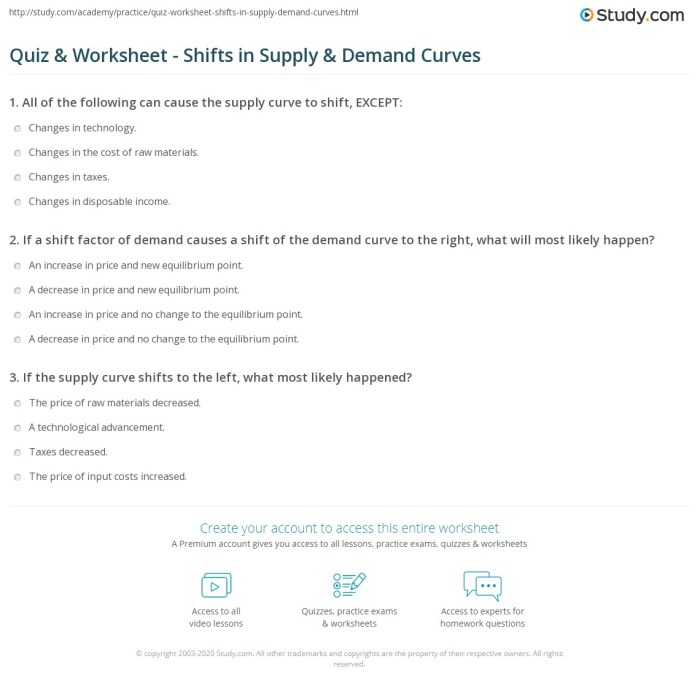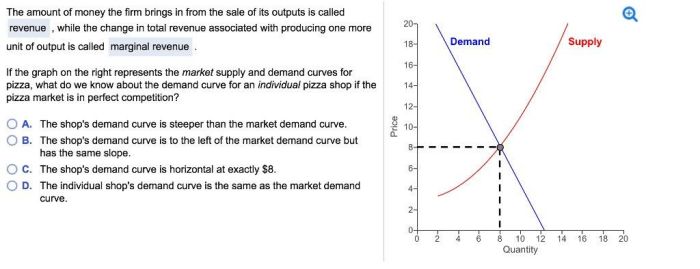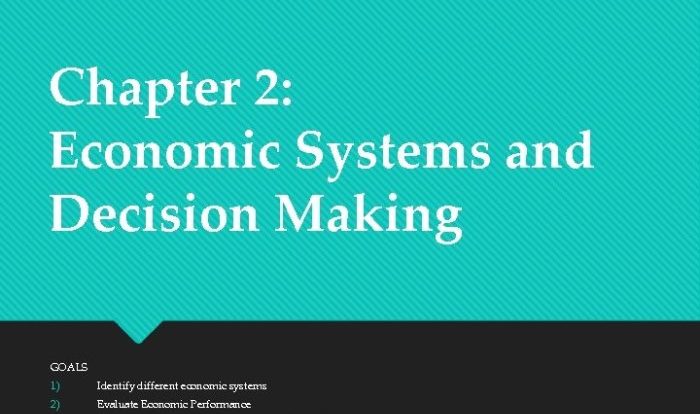The Shifting Supply and Demand Worksheet is an invaluable tool for comprehending the dynamic interplay between supply and demand in the marketplace. This worksheet guides users through the factors that influence shifts in supply and demand, empowering them to analyze and predict market equilibrium with precision.
By delving into real-world examples and employing graphical representations, the worksheet provides a practical framework for understanding how changes in consumer preferences, technological advancements, and other factors impact supply and demand. This knowledge is crucial for businesses and policymakers alike, enabling them to make informed decisions and develop effective economic strategies.
Market Equilibrium
Market equilibrium is a state in which the quantity of a good or service supplied is equal to the quantity demanded at a given price. At this point, there is no shortage or surplus of the good or service, and the market is said to be in equilibrium.
Examples of Market Equilibrium
- The market for wheat: At a given price, farmers are willing to supply a certain amount of wheat, and consumers are willing to demand a certain amount. If the price is too high, farmers will produce more wheat than consumers are willing to buy, leading to a surplus.
If the price is too low, consumers will demand more wheat than farmers are willing to produce, leading to a shortage. The equilibrium price is the price at which the quantity supplied equals the quantity demanded.
- The market for labor: At a given wage rate, employers are willing to hire a certain number of workers, and workers are willing to supply a certain amount of labor. If the wage rate is too high, employers will hire fewer workers than workers are willing to supply, leading to unemployment.
If the wage rate is too low, workers will demand a higher wage rate, leading to a shortage of labor. The equilibrium wage rate is the wage rate at which the quantity of labor supplied equals the quantity of labor demanded.
Factors that can Shift Market Equilibrium, Shifting supply and demand worksheet
Market equilibrium can be shifted by changes in supply, demand, or both. For example, an increase in supply, such as a technological innovation that reduces the cost of production, will shift the supply curve to the right and lead to a lower equilibrium price.
An increase in demand, such as a change in consumer tastes or preferences, will shift the demand curve to the right and lead to a higher equilibrium price.
- Changes in supply: A change in supply can shift the supply curve to the right or left, leading to a change in the equilibrium price and quantity.
- Changes in demand: A change in demand can shift the demand curve to the right or left, leading to a change in the equilibrium price and quantity.
- Changes in both supply and demand: A change in both supply and demand can lead to a shift in the equilibrium price and quantity in either direction, depending on the relative magnitudes of the changes.
Shifts in Supply and Demand: Shifting Supply And Demand Worksheet

Shifts in supply and demand refer to changes in the quantity supplied or demanded of a good or service at a given price. These shifts can significantly impact market equilibrium and influence prices.
Factors Affecting Shifts in Supply
Various factors can cause shifts in supply, including:
- Changes in input costs:Increases in the cost of raw materials, labor, or other inputs can lead to a decrease in supply.
- Technological advancements:Innovations that reduce production costs or increase efficiency can increase supply.
- Government policies:Regulations, subsidies, or taxes can affect the profitability of production, influencing supply.
- Natural disasters:Events like floods or droughts can disrupt production and reduce supply.
Shifts in Demand Due to Consumer Preferences
Changes in consumer preferences can significantly impact demand. Factors influencing these shifts include:
- Tastes and preferences:Changes in consumer tastes and preferences can alter the demand for specific goods or services.
- Income levels:Increases in income can lead to higher demand for certain products, particularly luxury goods.
- Demographic changes:Population growth, aging, or changes in household composition can influence demand for various products.
- Marketing and advertising:Effective marketing campaigns can create awareness and increase demand for products.
Impact of Technological Advancements on Supply and Demand
Technological advancements can have significant effects on both supply and demand:
- Increased supply:Innovations in production technologies can reduce costs and increase supply, leading to lower prices.
- Increased demand:New technologies can create new products or improve existing ones, stimulating demand.
- Changes in consumer behavior:Technological advancements can alter consumer preferences and habits, affecting demand.
- Disruption of industries:Technological advancements can disrupt existing industries, leading to shifts in supply and demand.
Analyzing Supply and Demand Shifts
Analyzing shifts in supply and demand is crucial for understanding how market equilibrium changes. By examining the factors that influence supply and demand, we can predict the impact of these shifts on market prices and quantities.
Step-by-Step Guide to Analyzing Supply and Demand Shifts
To analyze supply and demand shifts, follow these steps:
- Identify the factor causing the shift:Determine whether the shift is in supply or demand and the specific factor causing the change.
- Draw the initial supply and demand curves:Plot the original supply and demand curves to establish the initial equilibrium point.
- Shift the appropriate curve:If supply increases, shift the supply curve to the right. If supply decreases, shift the supply curve to the left. Similarly, shift the demand curve to the right for an increase in demand or to the left for a decrease in demand.
- Determine the new equilibrium point:The intersection of the shifted supply and demand curves represents the new equilibrium point.
- Analyze the impact on price and quantity:Compare the new equilibrium point to the initial equilibrium point to determine how price and quantity have changed.
Using Graphical Representations to Illustrate Supply and Demand Shifts
Graphical representations are a powerful tool for illustrating supply and demand shifts. By plotting the supply and demand curves, we can visually observe the impact of shifts on market equilibrium.
For example, an increase in supply will shift the supply curve to the right, leading to a lower equilibrium price and a higher equilibrium quantity. Conversely, a decrease in demand will shift the demand curve to the left, resulting in a higher equilibrium price and a lower equilibrium quantity.
Predicting the Impact of Shifts in Supply and Demand on Market Equilibrium
By analyzing supply and demand shifts, we can predict how market equilibrium will change. Some common examples include:
- Technological advancements:Innovations that increase productivity can shift the supply curve to the right, leading to lower prices and higher quantities.
- Changes in consumer preferences:Shifts in consumer tastes and preferences can shift the demand curve, affecting market equilibrium.
- Government policies:Government subsidies or taxes can influence supply and demand, impacting market prices and quantities.
- Natural disasters:Events such as floods or earthquakes can disrupt supply, shifting the supply curve and affecting market equilibrium.
Applications of Supply and Demand Analysis

Supply and demand analysis is a fundamental tool for understanding how markets function. It can be used by businesses to make informed decisions about pricing, production, and marketing. It can also be used by policymakers to develop effective economic policies.
Importance in Business Decision-Making
Supply and demand analysis can help businesses optimize their pricing and production strategies. By understanding the relationship between price and quantity demanded, businesses can set prices that maximize their profits. They can also use supply and demand analysis to forecast future demand and plan their production accordingly.
Real-World Examples
One example of how a business used supply and demand analysis to optimize its pricing is the case of the De Beers diamond cartel. De Beers controlled a large share of the world’s diamond supply, and it used this control to keep prices high.
By restricting the supply of diamonds, De Beers was able to create a shortage, which drove up prices.
Another example of how a business used supply and demand analysis to optimize its production is the case of the Ford Motor Company. In the early 2000s, Ford was struggling to compete with Japanese automakers. Ford used supply and demand analysis to identify the segments of the market where it could be most competitive.
The company then focused its production on these segments, and it was able to regain market share.
Policymaking
Supply and demand analysis can also be used by policymakers to develop effective economic policies. For example, governments can use supply and demand analysis to set minimum wages, regulate prices, and provide subsidies to businesses.
FAQs
What are the key factors that can shift supply?
Factors that can shift supply include changes in input costs, technological advancements, government policies, and natural disasters.
How can changes in consumer preferences lead to shifts in demand?
Shifts in demand can occur when consumer tastes and preferences change, leading to increased or decreased demand for specific goods or services.
What is the significance of supply and demand analysis in business decision-making?
Supply and demand analysis is crucial for businesses as it helps them optimize pricing, production levels, and marketing strategies to maximize profits.
